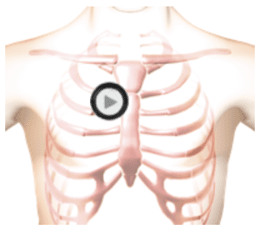First Heart Sound plus Aortic Ejection Click Auscultation Lesson with Recordings
Virtual Auscultation


The patient's position is sitting.
Lesson
A single first heart sound (S1) followed by an aortic ejection click (AEC) can also mimic a split first heart sound. An AEC follows S1 by 50 milliseconds. An aortic ejection click is caused by thickened aortic valve leaflets. This is commonly seen in a bicuspid aortic valve, a congenital abnormality where someone is born with two aortic valve leaflets instead of the normal three. Listen carefully to the second sound of the pair. If it is an AEC it will have a shorter duration and a higher pitch than the first sound of the pair (S1). The AEC is best heard at the Aortic valve area where splitting of S1 is not heard.Waveform
Heart Sounds Video
An aortic ejection click is caused by thickened aortic valve leaflets. This is commonly seen in a bicuspid aortic valve, a congenital abnormality where someone is born with two aortic valve leaflets instead of the normal three.
Authors and Sources
Authors and Reviewers
-
Heart sounds by Dr. Jonathan Keroes, MD and David Lieberman, Developer, Virtual Cardiac Patient.
- Lung sounds by Diane Wrigley, PA
- Respiratory cases: William French
-
David Lieberman, Audio Engineering
-
Heart sounds mentorship by W. Proctor Harvey, MD
- Special thanks for the medical mentorship of Dr. Raymond Murphy
- Reviewed by Dr. Barbara Erickson, PhD, RN, CCRN.
-
Last Update: 12/11/2022
Sources
-
Heart and Lung Sounds Reference Library
Diane S. Wrigley
Publisher: PESI -
Impact Patient Care: Key Physical Assessment Strategies and the Underlying Pathophysiology
Diane S Wrigley & Rosale Lobo - Practical Clinical Skills: Lung Sounds
- Essential Lung Sounds
Diane S. Wrigley, PA-C
Published by MedEdu LLC - PESI Faculty - Diane S Wrigley
-
Case Profiles in Respiratory Care 3rd Ed, 2019
William A.French
Published by Delmar Cengage - Essential Lung Sounds
by William A. French
Published by Cengage Learning, 2011 - Understanding Lung Sounds
Steven Lehrer, MD
- Clinical Heart Disease
W Proctor Harvey, MD
Clinical Heart Disease
Laennec Publishing; 1st edition (January 1, 2009)